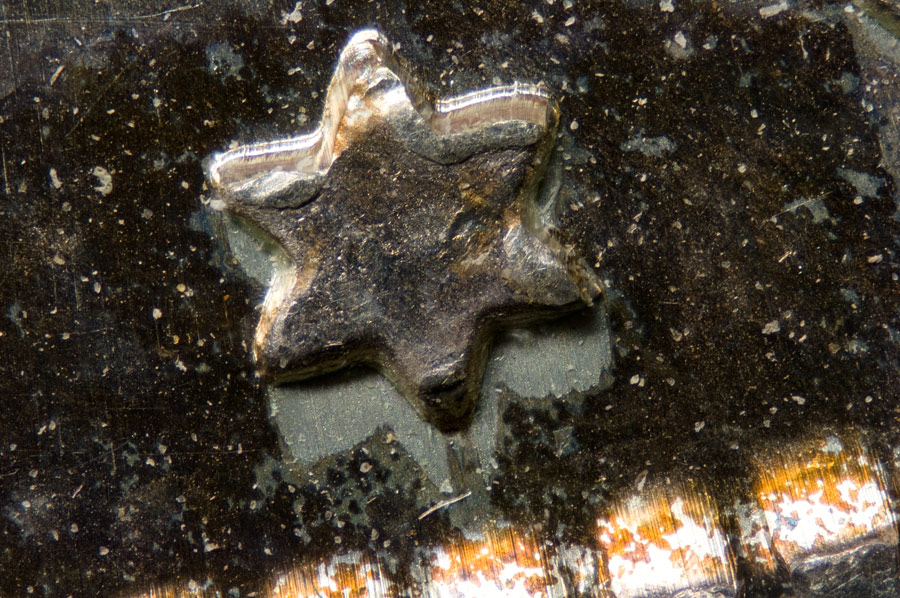Lens: Nikon BD Plan 5x/0.10 210/0
Vintage: 1990's.
Lens Mount: M26 x 0.75.
Needed Adapters: This lens has a larger mounting thread than traditional microscope objectives - 26 mm. There are adapters available on eBay that will adapt the M26 to a 52mm male filter thread. I use the inside threads of a 55 - 52 mm step-down ring as a male-to-male adapter. Then you can fit that onto a 52mm reversing ring specific to your camera.
Preferred Mounting: Normal, not reversed
Filter Thread: None
Street Price: $75-$150 in good used condition. Prices vary a lot online, shop around.
Controls: None.
Aperture: Fixed aperture, about f/4.2.
Basic Function: Requires a bellows to set focus and magnification
| Extension | Magnification | Working Distance |
| 10 cm | 3.86 | 25 mm |
| 13 cm | 4.67 | 24 mm |
| 16 cm | 5.46 | 23 mm |
| 19 cm | 6.26 | 21 mm |
| Est. Focal Length: 37.4 mm | ||
Appearance:


Things you need to modify before using: BD stands for brightfield/darkfield. The end cap and lens is designed to allow darkfield lighting. The lighting actually comes down the inside of the objective around the actual lens assembly. The end cap should be removed (will allow for more working distance). You will also need to plug up the gaps surrounding the lens assembly to prevent unwanted flare. I plugged the gap with some black cord.


 Corner Sharpness vs. Magnification:
Corner Sharpness vs. Magnification:
Corner sharpness is only so-so for this lens. Below 5:1 magnification, I would call it pretty bad. Above 5:1 magnification, it's OK.
 Sharpness and Resolution vs. Magnification:
Sharpness and Resolution vs. Magnification:
This lens shows good sharpness and resolution across its usable magnification range of 4x - 6x. Compared to lens that have a similar magnification range, it is good, but not great. Good 20 mm (Canon, Olympus) and 25 mm (Leica) bellows lenses will outperform this lens, mainly related to the larger apertures these lenses have.
This lens has a numerical aperture of 0.10. That corresponds to a working f/number of f/5 and traditional f/number of about f/4.2. The competitors work in the f/2.8 to f/3.5 range, allowing for more resolution.
 Performance: Sharpness vs. Magnification:
Performance: Sharpness vs. Magnification:
I have 4 lines that represent levels of performance from outstanding (top) to fair (bottom). This shows where this lens fits into the hierarchy that I have created.
The Nikon BD Plan 5/0.1 shows sharpness performance that varies from very good to good across the magnification range of 3.8:1 to 6.3:1.
 Performance: Resolution vs. Magnification:
Performance: Resolution vs. Magnification:
I have 4 lines that represent levels of performance from outstanding (top) to fair (bottom). This shows where this lens fits into the hierarchy that I have created.
The Nikon BD Plan 5/0.1 shows resolution performance that varies from good to fair across the magnification range of 3.8:1 to 6.3:1. This slight drop compared to the sharpness is likely related to the fixed aperture of about f/4.2 - relatively small for the magnification.
 Resolving Power vs. Magnification:
Resolving Power vs. Magnification:
This graph represents the smallest details that are able to be resolved by this lens at various magnificaitons. If the number doesn't get smaller as the magnification rises, there is little benefit to going up in magnificaiton with this lens. This situation is also called empty magnification.
Good resolution although losing some steam above 5:1. This is probably limited by the aperture.
Chromatic Aberration: This lens show minimal color fringing in the center (about 0.20 - 0.30 pixel) and fairly severe on the periphery (4-10 pixels). Anything below 1.0 pixel is good.
Image Contrast: Image contrast is good across the magnification range, typical for microscope objectives.
Flare: No significant flare is evident during lens testing, although the gaps on the inside of the lens do need to be plugged as stated above.
Distortion: There is slight distortion with this lens that I can see through the viewfinder, worst at lower magnification.
Image Samples:
About 4:1 magnification, focus stack of 29 images, resized:

 Pixel level crop from the image above:
Pixel level crop from the image above:
Good pixel level detail. The corners are clearly not sharp in the above image.
About 6:1 magnification, stack of 28 images, resized:

 Pixel level crop from the image above:
Pixel level crop from the image above:
Good detail for the magnification. The corner sharpness on the above image is considerably better than at 4:1.
Conclusion:
This is an easy to find and relatively inexpensive microscope objective that is fairly easy to adapt to the bellows although the end cap needs to be removed and internal lighting baffles need to be plugged.
It has good, but not great sharpness and resolution owing to its relatively small numerical aperture and can be outperformed by many good 20 mm and 25 mm bellows lenses. The main advantage that it does have over these other lenses is good working distance for the magnification.
The other limitation of this lens is that it doesn't have particularly sharp corners until you get above a magnification of about 5:1. There is also fairly severe chromatic aberration on the periphery and some mild distortion present. These factors are much more obvious during testing and are not as prominent in real world imaging.